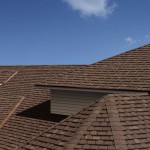Underlayment, also known as roofing felt or tar paper, is a layer of protection that roofers install between your roofing deck and the roofing shingles or tiles.
For many years, trade organizations like the National Roofing Contractors Association (NRCA) have recommended the use of underlayments with tile roof systems.
“An underlayment performs two primary functions,” the NRCA has written. “It provides temporary weather protection until the tile is installed, and it provides a secondary weatherproofing barrier should moisture migrate below the tile.”
Additionally, underlayment is used to comply with local building codes and to help keep dirt, dust, and bugs out of the building.
Underlayments are either made out of natural materials — wood cellulose, for example — or synthetics, such as fiberglass and polyester. They’re coated with asphalt to help repel water.
For the purposes of our blog discussion today, we’re going to focus on the synthetic underlayment.
Synthetic Underlayment
Synthetic underlayments are increasingly the material of choice for professional roofers and builders.
“In the early 2000s,” writes Jeff Avitabile, a GAF product manager, “there were a handful of synthetic underlayment products all trying to wrestle a sliver of the market away from asphalt felts. Today, there is an endless array of synthetic underlayment brands available, with more coming every day.”
A major factor driving an increase in synthetic underlayment applications is the enhanced walkability that the material permits in both wet and dry roofing conditions. Contractors are especially attuned to the benefits of synthetic underlayments, helping drive what Avitabile calls the “exponential growth” in the use of synthetics.
Staples and Synthetic Underlayment
Now to the questions at hand: Can staples be used to install synthetic underlayment? Or is it better to use cap nails? Which is better for underlayment that is going to be left exposed for an extended period of time?
Underlayment must retain its watertight integrity through all types of weather, including high winds and wind-driven rain. Modern synthetic underlayment provides some added protection to homeowners; many are designed to shed water, and others are able to withstand extreme UV exposure time.
As in any industry, if you ask several professionals about a particular subject, you might get several different answers. When it comes to determining the appropriate method of securing synthetic underlayment, the same holds true.
Staples vs. Cap Nails
Many roofers will tell you that staples are fine for installing the synthetic underlayment. Others will tell you that cap nails are more effective. Both options often depend on the slope of the roof itself.
Cap nails are typically made of steel and feature a plastic cap to prevent roof leaks, hence their name. But it’s important to understand that cap nails should only be used for securing roofing underlayment. So if you utilize them for this reason, remember that it’s the only reason to use them.
Many roofers argue that the use of cap nails to install synthetic underlayment provides an added measure of waterproofing if a high-wind event removes the top layer of shingles or tiles. In some parts of the country, cap nails are required for underlayments. They do a superb job of reducing the amount of tearing that can occur if the underlayment is exposed to the wind before the roof is fully shingled. With staples or plain roofing nails, the heads can sometimes tear right through the underlayment.
However, depending on local roofing and fire codes, it may be appropriate to secure synthetic underlayments with staples. They’re certainly faster and easier to install! Experienced roofers will tell you that once a house has been roofed, it doesn’t really matter if staples or cap nails were used to secure the underlayment roofing material. After all, they’re only there to hold the underlayment in place while a hundred pounds of shingles are placed on top of them.
It’s important to be aware that some synthetic underlay manufacturers will not warranty their products if they’ve been installed with staples. So make sure you do your homework!
Warner Roofing: Your Vancouver Roofing Expert
Another thing to remember: Underlayment of any type is only as good as the roofer who’s installing it. At Warner Roofing, we’re experts at what we consider to be the most important part of your home: a stable, durable roofing system.
Warner Roofing’s work is guaranteed to last. We offer a two-year warranty on repairs, a five-year warranty on second-layer roofs, and a 10-year warranty on complete tear-offs. We also provide 30- and 50-year warranties on materials.
Warner Roofing & Construction is your expert Vancouver roofer. We’re pros from start to finish, and we know the roofing business inside and out. We always go the extra mile to make sure our customers are satisfied with our work. Contact Warner Roofing today with any questions or to request an estimate.







